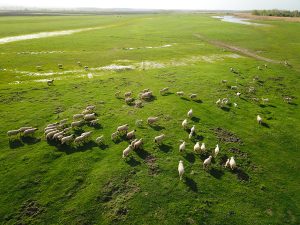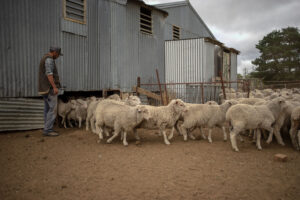Media headlines of an El Niño forecast coupled with classic drought images of dried ground next to tanks overdo our ability to forecast rainfall so far ahead. Sheep regions in the eastern seaboard will be moving from a wet spring in 2022 to a drier spring in 2023, whether it is a decile one or decile five spring rainfall is unknown. A simple model using historical rainfall levels can be used to project likely changes in production. In this article, we look at the average merino fibre diameter.
Mecardo last looked at the merino average fibre diameter and rainfall in October 2021 (read here), when it appeared that the swing in the merino micron, and the changes in fine and broad categories volumes which flow from that, was going to the drier/finer side. Rainfall in 2022 intervened, with good rainfall continuing in eastern Australia for the third year in succession, thereby delaying the swing in merino microns to the finer side.
In this article, we switch the rainfall data out for the calculated Long Paddock pasture growth rate (PGR) as the key driver of changes to the merino fibre diameter. In looking at the average merino micron from the late 1990s onwards, the downward trend (from breeding and the liquidation of broad merino sheep) has had to be adjusted for. That trend has stabilised during the past decade.
In Figure 1 the year-on-year change in the detrended eastern merino average fibre diameter from the late 1990s is compared to the year-on-year change in a weighted average 12-month percentile rank across eastern sheep regions for PGR, with a projected PGR shown for the coming year using median historic levels (from the past 40 years). The projections do not take into account any El Niño/La Niña projections but simply use median historic levels. As we are coming off a wet year, the drop in projected PGR (and rainfall) is substantial.
The projected outcome next autumn is a drop in the average merino micron of around 0.5 microns, a big drop. Figure 2 shows what such a swing finer in the average micron does for the different merino micron categories. Forecasting is a risky business at best, so the changes shown in Figure 2 only provide an idea of the changes which could happen. The result would be downward pressure on fine wool premiums and upward pressure on broad merino prices.
What does it mean?
The odds are that the merino fibre diameter will be finer in 2024, as a result of the upcoming spring being drier than in recent springs. The forecasts of an El Niño, while not telling us exactly how much rainfall is going to fall do forecast rainfall in the lower half of the possible distribution, helping confirm that we can expect a finer merino clip in 2024 with the attendant changes in production which that brings.
Have any questions or comments?
Key Points
- Simply because we are coming from a run of wet springs in eastern Australia, the odds are that the upcoming spring (even if it is a reasonable one) will be drier.
- A drier spring in 2023 means a finer merino clip in 2024.
- A finer merino clip in 2024 means more fine wool (downward pressure on fine micron premiums) and less broad merino (upward pressure on broad merino prices).
Click on figure to expand
Click on figure to expand
Data sources: AWEX, Long Paddock, ICS, Mecardo














